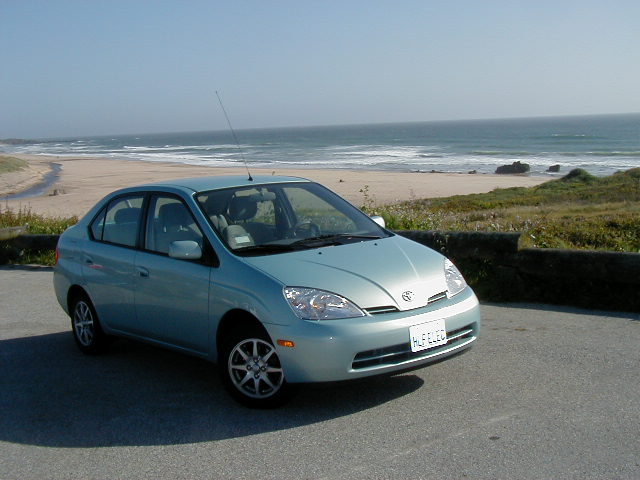
Why your next car should be a Hybrid
(or half-electric, as the license plate says)
How to design any car (these two essential questions select the design parameters):
1) Figure out how much the car will weigh (driven by size and engine weight).
2) Figure out how fast the driver wants to get on the freeway.
These two parameters constrain the engine size, and consequently, mileage performance.
The old (Detroit) way of designing a car:
3) Stick in an engine that generates enough torque to achieve acceleration 2) using the
weight from 1). Keep in mind that a larger engine adds weight, thereby
requiring a larger engine to preserve the acceleration criterium.
4) Using the engine size from 3) expressed in liters and the air fuel ratio for
maximum power is , it is now possible to get your fuel
mileage. For example, assuming you ended up with a 3.8L engine which is
busy putting out maximum power at 3000 RPM at 60MPH (1 mile per minute), the
amount of air consumed in 1 mile is:
intake air = 3000rev/min * 1 min * 1 intake/2 rev * 3.8L air / intake = 5700 litres = 5.7 x 10^6 cc of air.
optimum combustion occurs at about 15 grams of air per gram of fuel for maximum power during acceleration, and 45:1 for freeway driving. air density is 1.2 x 10^-3 g/cc and gasoline density is .68g/cc.
gasoline consumed in 1 mile = 5.7 x 10^6 cc air * 1.2 * 10^-3 g/cc air * (1 g fuel / 45 g air) * 1cc/.68g fuel * 1 liter/1000cc * 1gallon/3.8L = .06 Gallons, or 17 miles per gallon. Actual gasoline mileage is higher because fuel injection systems throttle back the fuel injection rate when the manifold vacuum is high, such as when coasting. (YMMV).
The new (hybrid) way of designing cars:
1) Figure out how much the car will weigh, and put an engine in which is sufficient only to maintain the vehicle speed at maximum freeway speeds of 90-100mph. In the Prius, this is a small 1.5L internal combustion engine (ICE). If you stop here, you'll have a dog of a car for acceleration (think Geo Metro), but good gas mileage.
2) Now add a high-torque electric motor and a battery sufficient to provide 10 minutes of heavy discharge. In the Prius, the electric motor provides 44HP of power and 258 ft-lb of torque to augment the 70HP and 85 ft-lb produced by the small internal combustion engine. During freeway driving, the ICE charges the battery.
3) Use the electric motor for braking to charge the battery, instead of heating brake linings. This produces the unexpected result that the stop-and-go city mileage performance is better than the highway mileage - opposite that of conventional automobiles.
This clever hybrid of mixing high torque electric motors and the long power duration of internal combustion engines produces a vehicle with very high gasoline mileage, and very strong rates of accelerations. There are many more subtle innovations in the prius:
1) The "electric motor" is actually two separate motors which sum their power with the internal
combustion engine (ICE), where the two motors can be used in three modes:
-two separate motors, combining power with the ICE during acceleration
-one a motor and the other a generator, both controlled by a system which keeps the ICE
turning at its optimum RPM (gasoline engines have an optimum power RPM and an optimum
torque RPM, which are different).
-regenerative braking which removes power from the wheels and transfers it to the battery for later use.
2) Starting an ICE at low cranking speeds is quite polluting. With the two electric motors,
the ICE can be cranked up to 1000RPM before gas is admitted, allowing a pollution-free start. Try that with your Buick
;-)
3) With a standing reserve of battery power, who needs an idling engine! The engine shuts off
when sitting in traffic, and the regenerative braking of stop and go driving is actually more efficient
than highway wind losses, which are not recoverable.
4) I have actually forgotten to buy gasoline and run the car dry several times. Ok, some of them
early on were intentional. No worries - the combination of the
GPS system (which identifies gas stations) and the battery has taken me to gas stations 10 minutes away.
There are lots of warning lights and buzzers along the way, but I haven't been spotted walking around town with a gas can as a result of these experiments ;-)
Jay's actual fuel economy for the past year:
Highway: 47MPG @ 75MPH (30 miles each way)
City: 55-60MPG
Mileage drops about 10% during the winter for the first 10 minutes
of driving in cold weather while the engine warms up.